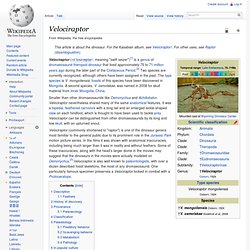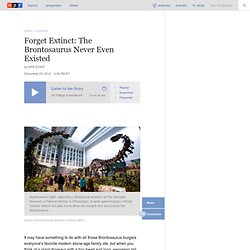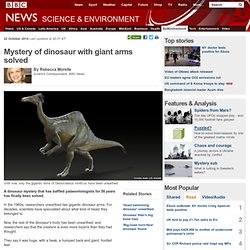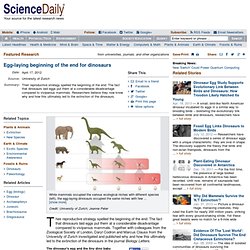

The other group, the Saurischians, included both the enormous long-necked dinosaurs, like Apatosaurus, as well as all known meat-eating dinosaurs, like Velociraptor and Tyrannosaurus rex. Birds are descended from Saurischian dinosaurs and are the closest living relatives to dinosaurs alive today. Bird Evolution. Dinosaur size chart. Dinosaur Found (Accidentally) by Miners in Canada. This article appears in the June 2017 issue of National Geographic magazine. On the afternoon of March 21, 2011, a heavy-equipment operator named Shawn Funk was carving his way through the earth, unaware that he would soon meet a dragon. That Monday had started like any other at the Millennium Mine, a vast pit some 17 miles north of Fort McMurray, Alberta, operated by energy company Suncor.
Hour after hour Funk’s towering excavator gobbled its way down to sands laced with bitumen—the transmogrified remains of marine plants and creatures that lived and died more than 110 million years ago. It was the only ancient life he regularly saw. In 12 years of digging he had stumbled across fossilized wood and the occasional petrified tree stump, but never the remains of an animal—and certainly no dinosaurs.
But around 1:30, Funk’s bucket clipped something much harder than the surrounding rock. “Right away, Mike was like, ‘We gotta get this checked out,’ ” Funk said in a 2011 interview. Spinosaurus Skeleton. 2020 Reconstruction of Spinosaurus. The "Fighting Dinosaurs" specimen. Smaller than other dromaeosaurids like Deinonychus and Achillobator, Velociraptor nevertheless shared many of the same anatomical features.

It was a bipedal, feathered carnivore with a long tail and an enlarged sickle-shaped claw on each hindfoot, which is thought to have been used to tackle prey. Velociraptor can be distinguished from other dromaeosaurids by its long and low skull, with an upturned snout. Description V. mongoliensis compared in size to a human Velociraptor was a mid-sized dromaeosaurid, with adults measuring up to 2.07 m (6.8 ft) long, 0.5 m (1.6 ft) high at the hip, and weighing up to 15 kg (33 lb).[4] The skull, which grew up to 25 cm (9.8 in) long, was uniquely up-curved, concave on the upper surface and convex on the lower. Skeletal restoration. Forget Extinct: The Brontosaurus Never Even Existed. Hide captionApatosaurus (right, opposite a Diplodocus skeleton at the Carnegie Museum of Natural History in Pittsburgh), is what paleontologist Othniel Charles Marsh actually found when he thought he'd discovered the Brontosaurus.

Joshua Franzos/Carnegie Museum of Natural History Apatosaurus (right, opposite a Diplodocus skeleton at the Carnegie Museum of Natural History in Pittsburgh), is what paleontologist Othniel Charles Marsh actually found when he thought he'd discovered the Brontosaurus. It may have something to do with all those Brontosaurus burgers everyone's favorite modern stone-age family ate, but when you think of a giant dinosaur with a tiny head and long, swooping tail, the Brontosaurus is probably what you're seeing in your mind. Well hold on: Scientifically speaking, there's no such thing as a Brontosaurus. Even if you knew that, you may not know how the fictional dinosaur came to star in the prehistoric landscape of popular imagination for so long. First dinosaur ever found with both feathers and scales. First Dinosaur Tail Found Preserved in Amber.
Watch: Pictures of the First Dinosaur Tail Ever Preserved in Amber While individual dinosaur-era feathers have been found in amber, and evidence for feathered dinosaurs is captured in fossil impressions, this is the first time that scientists are able to clearly associate well-preserved feathers with a dinosaur, and in turn gain a better understanding of the evolution and structure of dinosaur feathers.

Mystery of dinosaur with giant arms solved. 22 October 2014Last updated at 20:31 ET By Rebecca Morelle Science Correspondent, BBC News Until now, only the gigantic arms of Deinocheirus mirificus have been unearthed A dinosaur mystery that has baffled palaeontologists for 50 years has finally been solved.

First Venezuelan dino provides clues to dinosaur evolution. Longest Dinosaurs. Museum features two T-rex's going at it. Egg-laying beginning of the end for dinosaurs. Their reproductive strategy spelled the beginning of the end: The fact that dinosaurs laid eggs put them at a considerable disadvantage compared to viviparous mammals.

Together with colleagues from the Zoological Society of London, Daryl Codron and Marcus Clauss from the University of Zurich investigated and published why and how this ultimately led to the extinction of the dinosaurs in the journal Biology Letters. The dinosaur's egg and the tiny dino baby Weighing in at four tons, the mother animal was 2,500 times heavier than its newly hatched dinosaur baby. By way of comparison, a mother elephant, which is just as heavy, only weighs 22 times as much as its new-born calf. In other words, neonates are already big in large mammal species.
Many species occupy one niche each; one species occupies many niches In addition, new-born mammals occupy the same ecological niche as their parents: As they are fed with milk directly by the mother, they do not take any niche away from smaller species. Artist interpretation of a Dakotaraptor and her chicks.